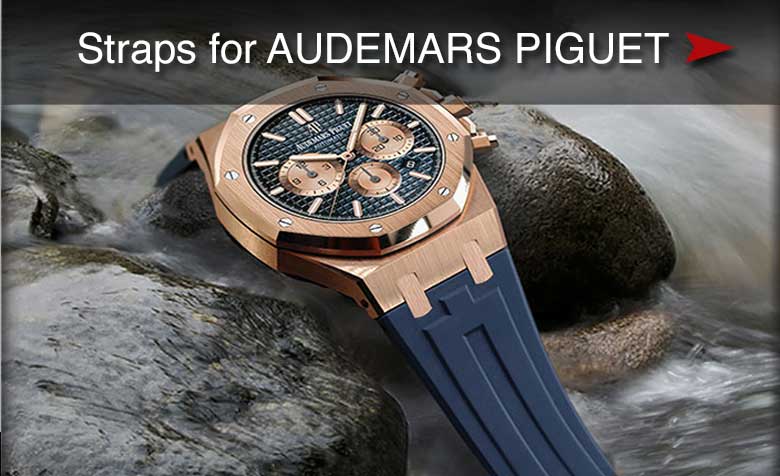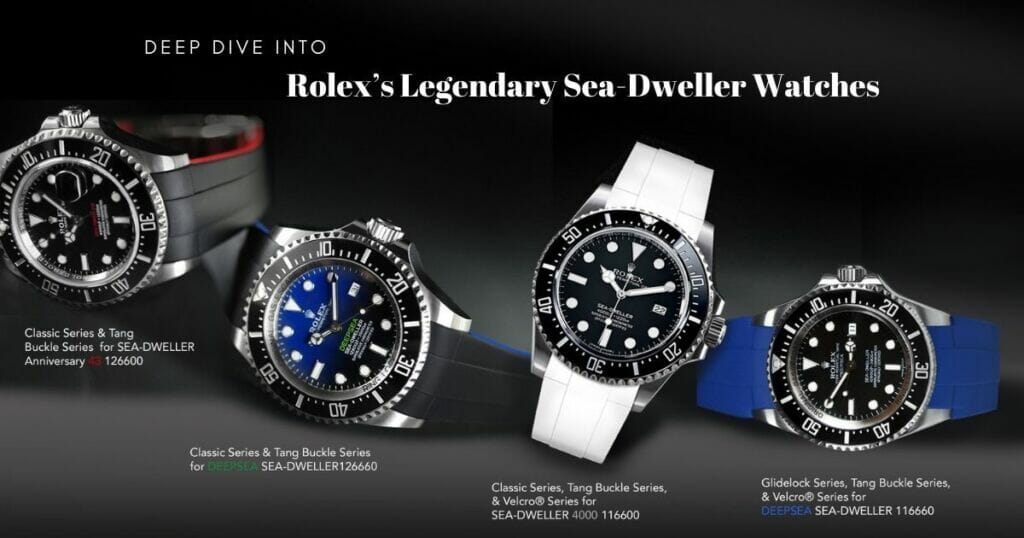
Rolex, simply put, is the most eminent name in the world when it comes to the luxury watch market. There is no other manufacturer of luxury timepieces that has the same kind of immediate recognition – the cultural cache, if you will. If you see a character wearing a Rolex in a movie, it allows you to know a multitude of things about the character without a single word of dialogue being spoken. There are many brand names that work their entire lives to get that kind of name recognition and simply never manage to do, despite their best efforts. And funnily enough, Rolex has a long and interesting history with certain figures in the movie industry – something we will explore at great depth later on in this piece.
Rolex has managed to do this, in part, by making watches that do things that, at the end of the day, other watches cannot do – or do nearly as well. The end result is that Rolex has spent the last 60 or so years cultivating loyalty among its customers among certain styles of watches – however, as with everything else in the world, some products are just naturally going to connect more with an audience than others. A significant part of Rolex’s success has been their ability to adapt and change with the market over time, and they are very adept at reinventing their image, and the image of their respective products, without having ever compromised the quality of the watches they are so well-known and loved for making in the first place.
One of Rolex’s most popular, albeit sometimes controversial watch series, has been the Sea-Dweller series, which has been around in some form or fashion since 1953. There’s an unusually complex narrative around both the making of this watch, and how it would eventually find its way onto the wrist of arguably the biggest film director in the world – and we want to tell you all about it, as the story is rather fascinating, and also a bit complex. For what it’s worth, we’re sure the director we’re tacitly mentioning here wouldn’t have it any other way.
To truly understand this though, there are two separate histories here that we need to understand from the beginning so that we can fully appreciate the full scope of the narrative. The first is the history of Rolex, and specifically their Sea-Dweller watches, and the other is the history of this mystery director – we promise that we’ll name him later in the article, but as any good movie maker will tell you, you don’t want to give the entire story away in the first act!
Once we have done all of that, we can go more into the connection of these two titans of their respective industries – where they first linked up, and how they would eventually go on to make history together (and if you’re a trivia fan, there’s a really great piece of trivia that will come up when we cover that section later.)
After we’ve completed our history lesson in full, we’ll go more into the nuts and bolts – quite literally – of the most current models of the Rolex Sea-Dweller (even that is going to get a bit weird and complicated, as you’ll see when we hit that stop along our grand tour here.) Finally, after all of that is said and done, we’ll tell you more about the wonderful custom rubber watch straps that Rubber B has for both of the most current iterations of the Rolex Sea-Dweller, and why they’re definitely worth your time if your any kind of watch collector.
We know this sounds like a lot to take in, but we promise, the ride is going to be informative, informal, and interesting – kind of like a tour of a quaint brewery, but without the beer! So get ready to strap in, lean back, and enjoy the ride as we take you through the wild, and sometimes very wooly, history of the Rolex Sea-Dweller line of watches.
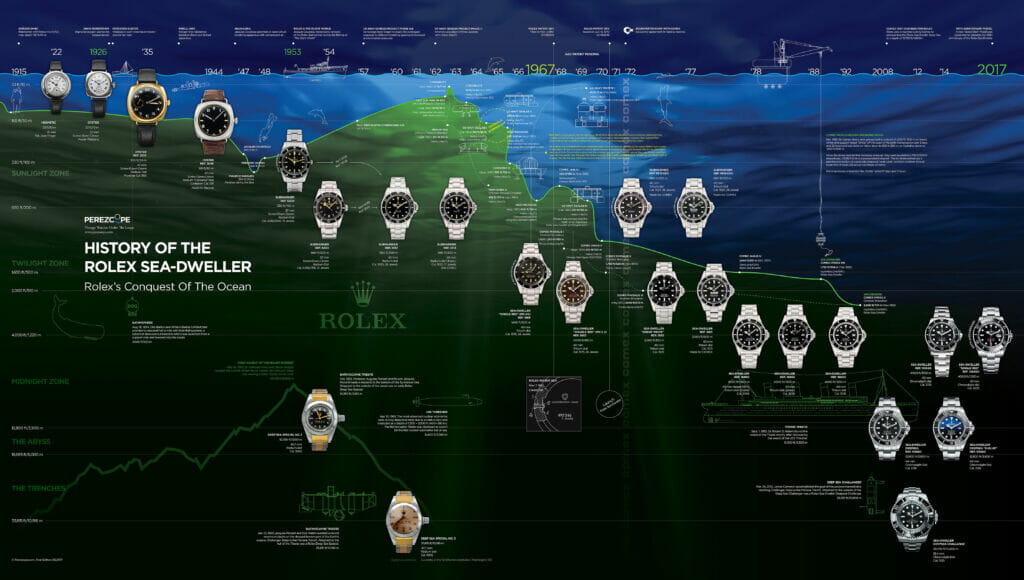
What is the History of Rolex, And Specifically, The Rolex Sea-Dweller?
Though you wouldn’t think of it now due to their luxurious and ostentatious image, Rolex, as so many other businesses do, initially began as a family affair. It was founded in London in 1905 by Alfred David and his brother-in-law, Hans Wilsdorf. The company was originally founded as Wilsdorf and Davis, though it would later come to be known as Rolex S.A.
They gained prominence in England by importing Swiss watch movements made by Hermann Aegler and placing them in watch cases made by other manufacturers of the time, primarily Dennisson. Those wristwatches would then be sold to other jewelers, who would put their own names on them – at this point, it feels like we’re going to need notecards to keep track of all of these names, right?
However, Wilsdorf and Davis were pretty smart – they managed to personalize each of their watches by have ming the initials “W&D” placed into the caseback. 1908 became a big year for the company, as they would formally trademark the name “Rolex,” which, by that point in time, had become known as the brand name of the watches that the pair sold. That same year, the pair opened an office in La Chaux-de-Fonds, Switzerland, a place the company will forever be associated with. According to legend, Wilsdorf chose the name “Rolex” for two reasons: the first was that he wanted it to be simple to pronounce and small enough to fit on a watch. The second is that he liked the way it sounded – it reminded him of a watch being wound, which is obviously very fitting in this instance.
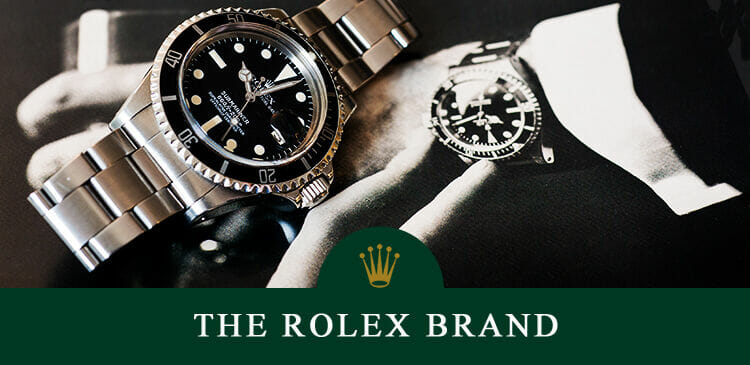
1914 was, however, in many ways, the year that truly put Rolex on the map and turned them into an internationally recognized brand. This was because the King’s Observatory (which was called the Kew Observatory at the time) gave one of Rolex’s watches a Class A precision certificate. These certificates were only normally granted to marine chronometers, which are watches that are known for being among some of the most accurate in the world. They gained this name because they were used to keep track of time at sea, and were the first watches that were accurate enough to help sailors navigate, which was a revolutionary development at the time.
When Rolex received one of these distinctive certificates, it made people sit up and take notice as to just how accurate their luxury timepieces were, and a global icon in watches began to be born. In 1915, the company changed its name to Rolex Watch Co. Ltd, and in 1919, they moved to Switzerland permanently to escape high taxes.
Finally settled and established, Wilsdorf wanted to turn the company’s attention to a true technical challenge – making a watch that would not only be dustproof but waterproof, which had never successfully been accomplished before. In 1926, they developed and revealed the world’s first waterproof watch, which they named “Oyster.” The trick to solving the problem? They developed a hermetically sealed case, which allowed the movement to be protected underwater while still traveling to great depths.
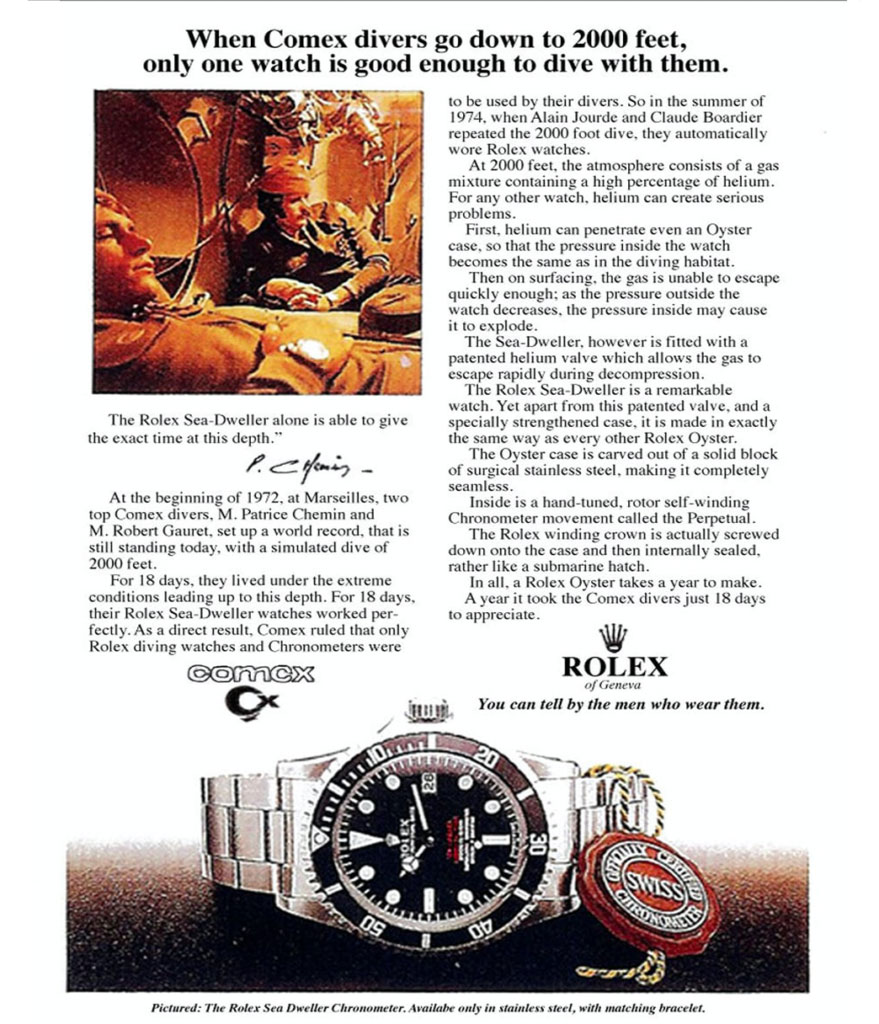
Rolex then began to develop a reputation as the “underwater watch” company, which helped them separate themselves from their competitors. Though the public was initially skeptical at first, Rolex managed to assuage their fears about whether the watch was really waterproof by doing demonstrations where they submersed their luxury watches into aquarium tanks. In 1927, a British swimmer named Mercedes Gleitze swam the English Channel, and in the process, became the world’s first Rolex ambassador.
What Led to The Development of the Rolex Sea-Dweller?
In the 1950’s, a massive sea change happened in the world – quite literally. Scuba diving, which has previously been seen as only a pursuit available to the wealthy, was starting to become more mainstream among everyday people. This was due in no small part to Jacques Cousteau, the legendary French underwater explorer, and the multitude of documentaries he made that showed people the sea in a way they had never previously been able to see it before.
Cousteau, a former French naval lieutenant, was one of the inventors of the Aqua-Lung, which allowed him and his associates to dive more deeply, which in turn aided them in their ability to film some of the world’s first underwater documentaries. This made adults and children alike suddenly discover an interest in both casual diving and scuba diving across the globe.
Rolex was rather savvy and noticed the new trend, and in 1953, they made their first official deep-sea diving watch, which they called the Sea-Dweller. These watches were specially designed to accompany divers on their plethora of deep-sea adventures without ever breaking. There was a specific problem that Rolex had to overcome, however, before they could successfully develop the watch.
How Was Rolex Able to Get the Rolex Sea-Dweller to Work Underwater?
Rolex already had an established history of pulling off some pretty impressive engineering feats by the time the 1950’s had rolled around, but making a watch that could withstand the sometimes harsh conditions of deep-sea diving was truly a piece de resistance among their many notable feats.
They had a truly difficult problem to solve – when a diver returned to the surface, they had to slowly decompress to allow all of the gases that built up in their body from being underwater to be safely expelled. Without doing so, they could suffer from a particularly painful condition called “the bends,” or decompression sickness.
The condition caused a variety of symptoms, including joint pain, rashes, paralysis, and death. “How does this factor into making a watch?” you might be asking yourself right about now – that’s an excellent question, dear reader, and one we’ll be happy to answer for you.
When divers tried to bring watches underwater, they would often break because of the very same gases that caused decompression sickness in the first place. From a scientific standpoint, there was no way to remove the gasses from the equation – if you went diving, you, and your watch had to be able to handle the decompression. So how do you manage to work around that?
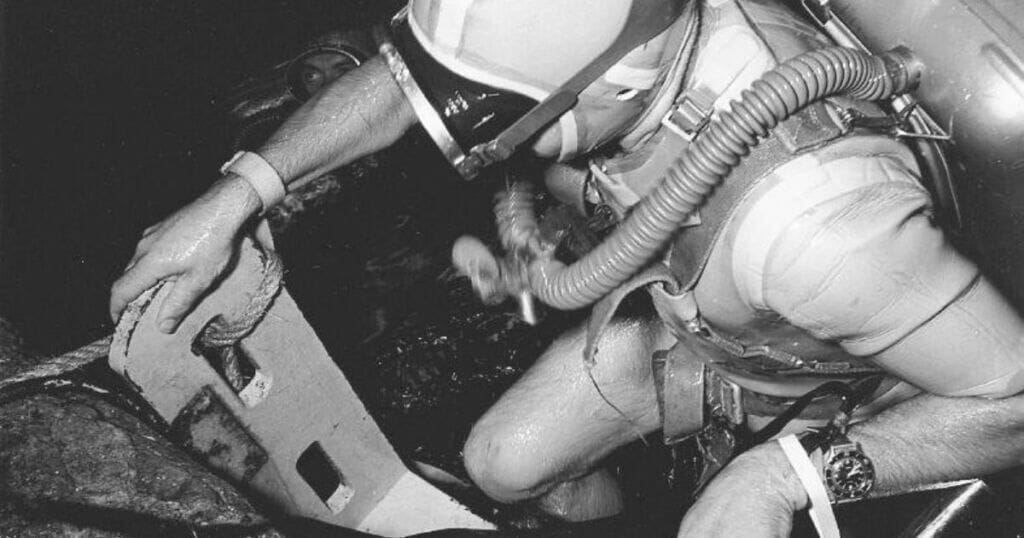
As usual, Rolex managed to come up with a solution that was both simple and elegant. They realized that there was no way to eliminate the gases entirely, but that did not mean that they had to allow them to stay inside the watch and build up pressure the entire time. This prompted Rolex to install a tiny pressure release valve into the bracelet of the watch that would allow a diver to slowly decompress their watch while underwater, thereby preventing the buildup that always damaged the watches in the first place.
Prior to this point, this had never been done before. Rolex had managed to innovate in a way that completely changed the way people would be able to use their watches. The naval branches of various countries suddenly began to take an interest in Rolex’s new technology, as it had seemingly endless military applications, in addition to being used for civilian diving purposes.
In short, Rolex has a long and storied history when it comes to innovation, and the manufacturing of, underwater and dive friendly watches. As such, they continue to lead the way in the field of underwater watches, and we will surely continue to see them continue to be leaders in the field they helped pioneer for years to come.
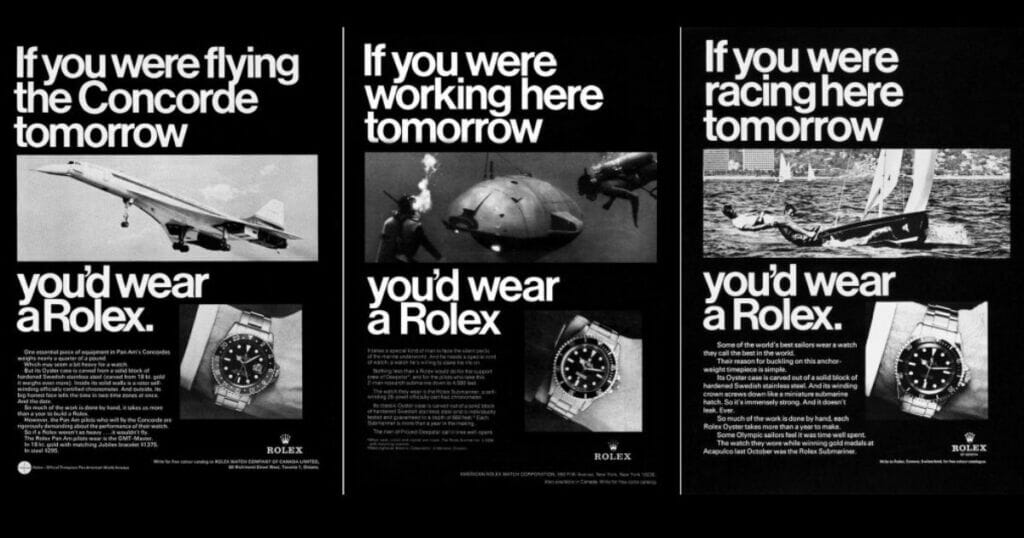
However, the military and divers were far from the only people taking an interest in Rolex watches. They would soon catch the attention of a number of Hollywood celebrities and athletes alike, who began to collect and display them as status symbols. Hollywood film directors certainly were not exempt from this trend, but there was one particular man who managed to insert himself into both Hollywood and Rolex’s histories forever, and become a legend in the process.
His name? James Cameron.
A (Not So) Brief History of James Cameron
It turns out that James Cameron has a pretty long and well-documented relationship with Rolex, but before we get into that, it’s worth taking a longer look at the man himself to see how their paths managed to intersect in the first place.
If we’re really being honest, it’s pretty unlikely that you don’t know who James Cameron is, but for the sake of the five people in the world who may not, James Cameron isn’t just a film director – he is, arguably, the film director when it comes to big-budgeted Hollywood spectacles. Yes, we know that Spielberg and Hitchcock are also really important, but did either of those guys direct Avatar, which was the highest grossing film in history until Avengers: Endgame came out? No, no they did not.
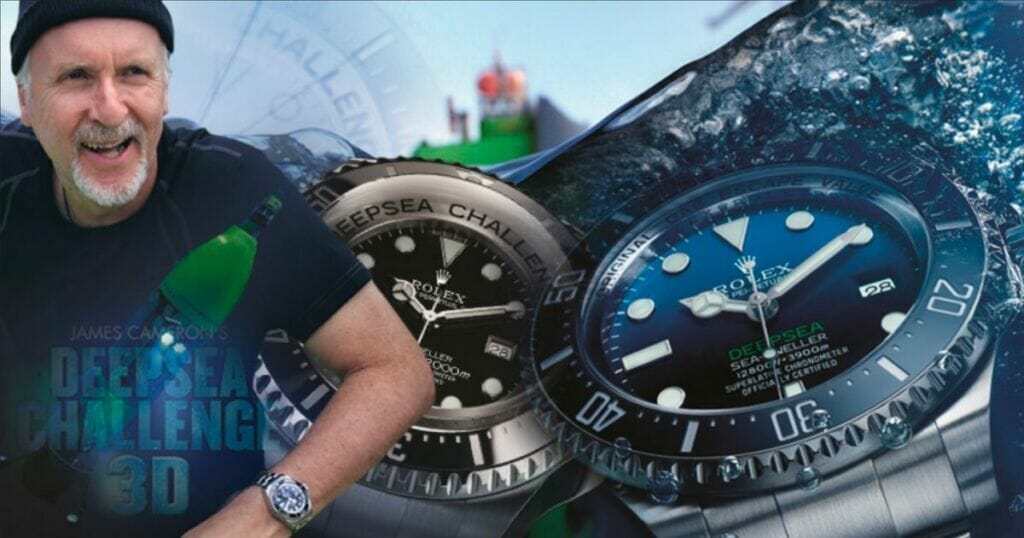
In addition to being the guy who brought us the Terminator, James Cameron is also an environmentalist and an engineer – remember that last one, as it’s going to explain a lot later on this piece. He was born in Ontario in 1954 and, as a kid, had a passion for both nature and technology, especially where building things was concerned. By his own admission, instead of playing sports, he was much more interested in building things that “either went up into the air or into the deep.” He also, surprise surprise, really loved going to the movies as well.
He would also develop a strong fascination with the Titanic during this time – it’s a well-known fact that he literally made that movie so that he could get Paramount to pay for him to go visit the wreck with a deep-sea dive team as part of his research for the film. Ahh – don’t you love the sound of science on someone else’s dime in the morning?
He had initially enrolled in college as a physics major, but he would eventually end up switching over his major to English. He would end up leaving college entirely and working a series of odd jobs, including as a janitor and a truck driver – anything that would give him free time to write. He also spent a lot of time learning about special effects in film by reading books in the library. In 1977, Cameron underwent what many people at the time described as a religious experience – he saw Star Wars for the first time.
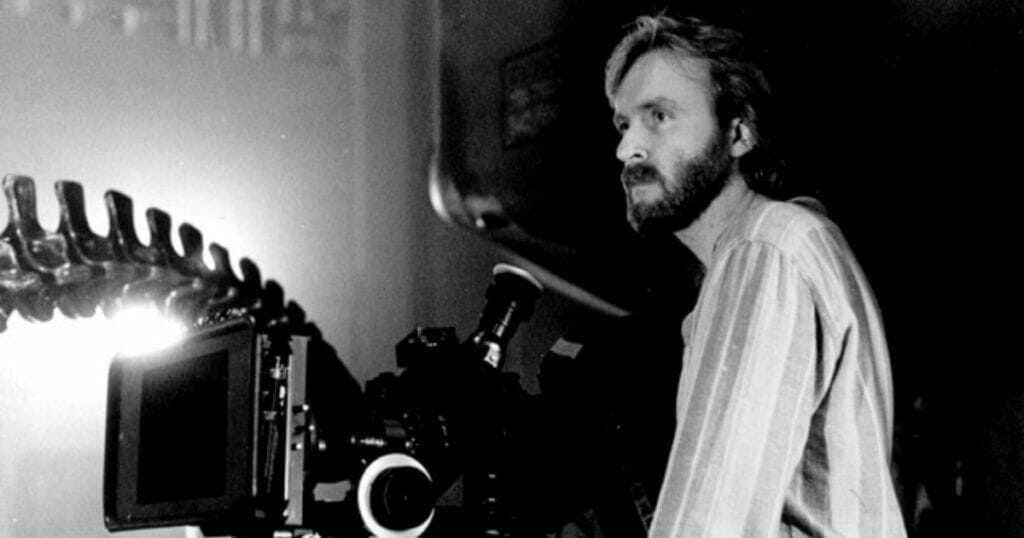
After that, Cameron quit his job as a truck driver because he had finally found his true calling in life – to be a filmmaker. In 1978, he wrote, directed, and produced his first short film, which was entitled Xenogenesis, with the help of a friend. Due to the learning curve that he encountered along the way, Cameron has said that the process made him feel “like a doctor doing his first surgical procedure.” While he was continuing to learn about filmmaking, he got a job as a miniature model maker at Roger Corman Studios. For those of you who don’t know who Roger Corman is, go look him up – he launched the directing careers of James Cameron, Jonathan Demme, Ron Howard, and about 50 other people you love. The man has seriously launched more people into the stratosphere than NASA.
In 1982, Cameron was hired as the special effects director for a “creature feature” called Piranha 2. The original had been made to capitalize off of the success of Jaws from a few years earlier, and Cameron was excited to have a larger role on a larger picture for the first time. During the production of the film, its original director, Miller Drake, left the production due to creative disagreements with producer Ovidio Assonitis.
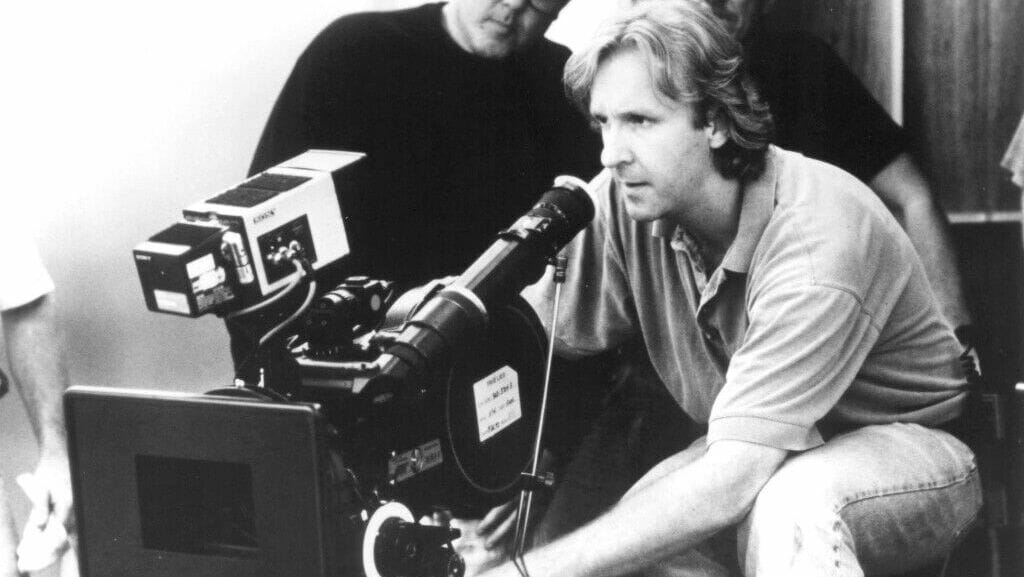
As a result of this, Cameron was given the opportunity to step into the director role himself for the first time. However, Cameron would end up having his own differences with Ovidio Assonitis, and the final film was heavily recut by the producer. In fact, the film was so significantly recut that Cameron ended up asking for his name to be taken off of it upon its completion.
To top it all off, Cameron developed an illness while the film was shooting in Rome. During this time, he had a terrible fever dream about a robot assassin who had been sent to kill him for the future. Does any of that sound familiar to you? It should, because it was the inspiration for one of the greatest sci-fi/action films ever made: The Terminator.
Beginning in 1982, Cameron would begin writing the script for The Terminator, which would eventually be released in 1984. The resulting success of that film would make a star out of not only Cameron himself, but of its two primary leads: the wiry and ferocious Linda Hamilton, and the hulking, highly menacing wall of humanity that was Arnold Schwarzenegger in the early 1980’s.
Cameron’s career trajectory was permanently altered after that – he was an A-list writer/director now, and people all across Hollywood wanted to work with him after that. He would eventually go on to co-write the script for Rambo 2 with the film’s star, Sylvester Stallone. His next directorial effort after that, Aliens, which was a sequel to Ridley Scott’s sci-fi masterpiece, is considered to be one of the best sci-fi/action films ever made.
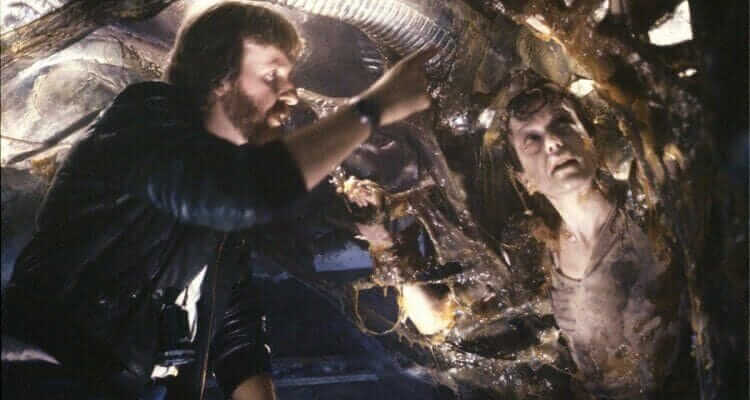
From there, the world only continued to be Cameron’s oyster, and he took full advantage of it. He’d always had an interest in deep-sea exploration, and he found a way to finally indulge that by making the film The Abyss in 1989. While the film was relatively well-received by critics and audiences, the making of the film, which involved a lot of underwater tanks, was traumatic for the cast and crew. Even to this day, Ed Harris, who was the lead, refuses to speak about the making of the film at all, due to the fact that he almost drowned while making it. He would also marry Kathryn Bigelow this same year, though the marriage would be short-lived, as the couple divorced (rather acrimoniously, as you’ll see in a few moments) just two years later, in 1991.
The early 1990’s would see Cameron begin to make a number of moves to cement his reputation in Hollywood as a permanent power player. In 1990, he would co-found the production company Lightstorm Entertainment with one of his producing partners, Lawrence Kasanoff. He would also serve as an executive producer on his wife’s film Point Break, which has since gone on to attain a large cult following in the years afterwards.
In 1991, Cameron would deliver what many film lovers will say is his magnum opus – Terminator 2: Judgement Day. If there had ever been any doubt about Cameron’s clout or talent behind the camera before then, this film completely demolished those doubts and went on to become the highest-grossing R-rated film ever (at the time.) The film reunited its two stars from the previous installment, Arnold and Linda Hamilton, and also made a household name out of Robert Patrick, who became one of the most menacing villains in cinema history as the T-1000.
Cameron wanted to follow up this up by directing a third Terminator film, but he was unable to do so, and the rights would eventually be purchased by producer Mario Kassar from a bankruptcy sale of the company who owned them. This eventually caused him to focus his interests elsewhere, and in 1993, he founded a special effects company called Digital Domain.
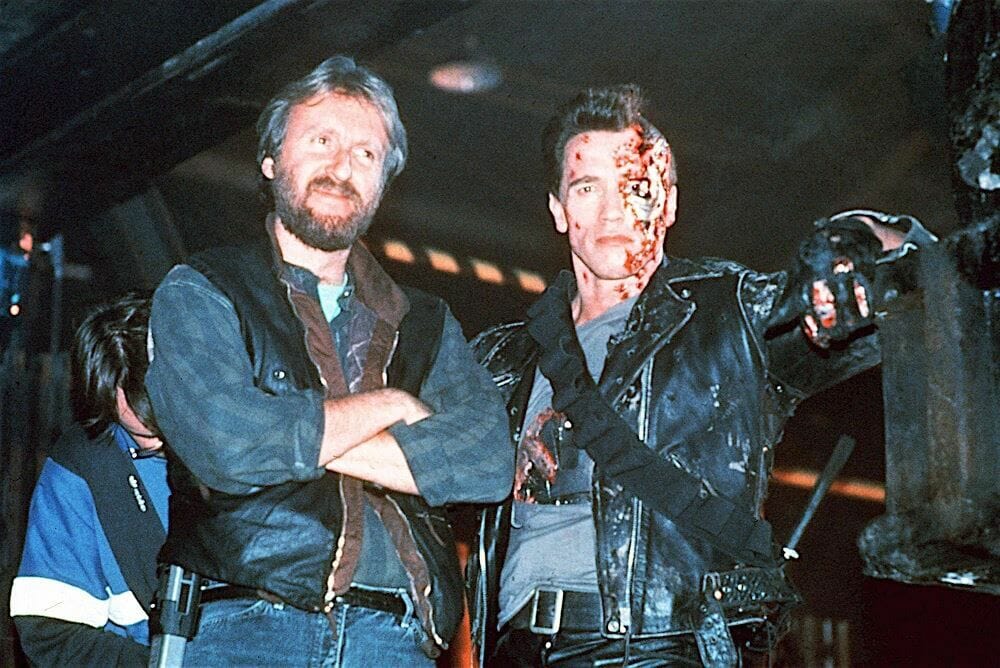
By the way, remember that acrimonious divorce we mentioned a little while ago? It was because Cameron cheated on his wife and began a new relationship with Linda Hamilton. The two would eventually marry, but that relationship would be short-lived as well, as the couple would divorce in 1999, only two years after they were married.
His next project would arrive in 1994, and is notably the only comedy in Cameron’s entire oeuvre. True Lies was a remake of a French spy comedy, La Totale!, and once again starred Arnold Schwarzenegger as a secret agent who must hide his identity from his wife, played by the inimitable Jamie Lee Curtis. The film was well received and a modest box office success at the time, and though they have attempted to get a sequel off the ground for years, it looks unlikely that it will ever happen at this point in time.
In 1995, Cameron would go on to produce a film for ex-wife Kathryn Bigelow entitled Strange Days, which would star Ralph Fiennes as a futuristic PI trying to solve a murder case and, of course, getting caught up in a vast conspiracy in the process. Much like her first film, though it only produced a modest box office return at the time, it has since gone on to become a beloved cult classic.
In 1997, Cameron would go on to release the film that still, to this day, defines his legacy – you know, the one we all still make fun of, the one that explains why we recoil whenever Celine Dion’s “My Heart Will Go On” is played in a grocery store. Of course, we’re talking about the one and only Titanic.
Finally wanting to move away from the action genre for a little while, Cameron wanted to make a film that would allow him to return to one of his earliest loves – deep-sea exploration. He had wanted to see the Titanic in person for years, but because of the cost of doing so, he had no way to actually realize this dream – so he came up with a rather brilliant solution.
After writing the screenplay for Titanic, he went to see Sherry Lansing, who was, at the time, the head of Paramount Studios. He made her a very simple offer – if they were willing to pay for him to visit the Titanic as part of his research for the film, he would forego his regular directing salary and only be paid from the film’s box office. Lansing immediately jumped on the offer, and Cameron would finally get to fulfill his dream.
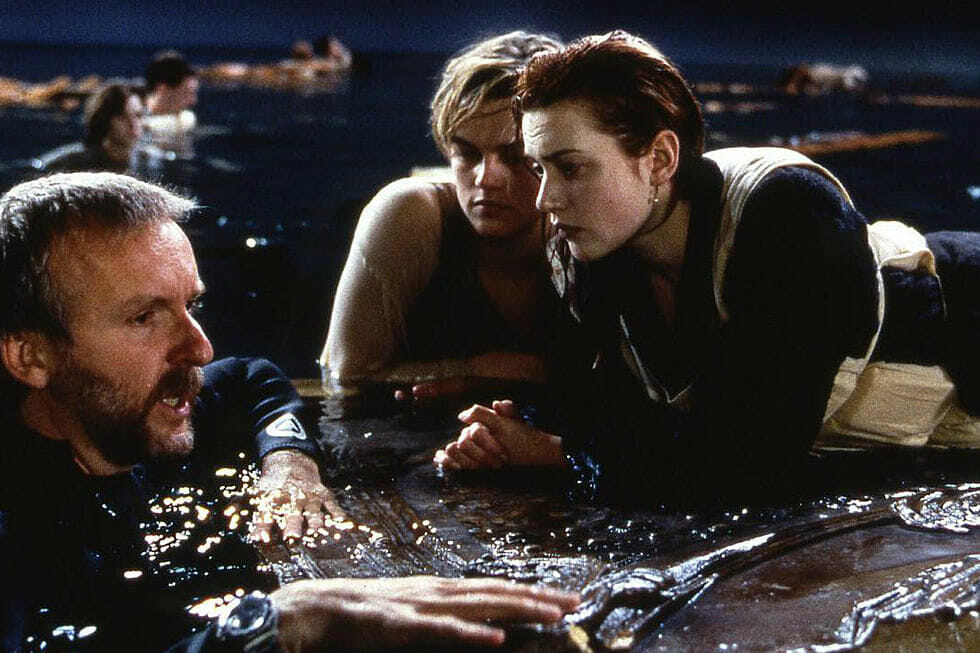
When Titanic was finally released in 1997, it changed the lives of everyone who worked on it forever. Leonardo DiCaprio went from a minor character actor to a leading teen heartthrob overnight, and Kate Winslet was introduced to many American moviegoers for the first time as well. The film not only shattered box office records at the time (thanks teenage girls in 1997), but it also went on to win 11 Oscars, including Best Picture.
For many, the main draw of the film was its realistic recreation of the sinking of the Titanic, which saw Cameron once again up to his old tricks by having his actors submerged in water tanks. Nothing like it had been previously attempted up to that point, and it made Titanic one of the most expensive films ever made at the time of its release. Don’t worry, though – the movie more than made its money back, and everyone involved at Paramount got to keep their jobs and lived happily ever after.
It would be another 11 years before Cameron returned to the director’s chair, in 2009. What took him so long? Simply put, the technology did not yet exist for Cameron to realize his vision for Avatar at the time. In order to tell the story of Avatar, which deals with an alien race that is being attacked by humans for their natural resources, Cameron needed 3D actors – in short, motion capture technology, and cameras that could successfully film them.
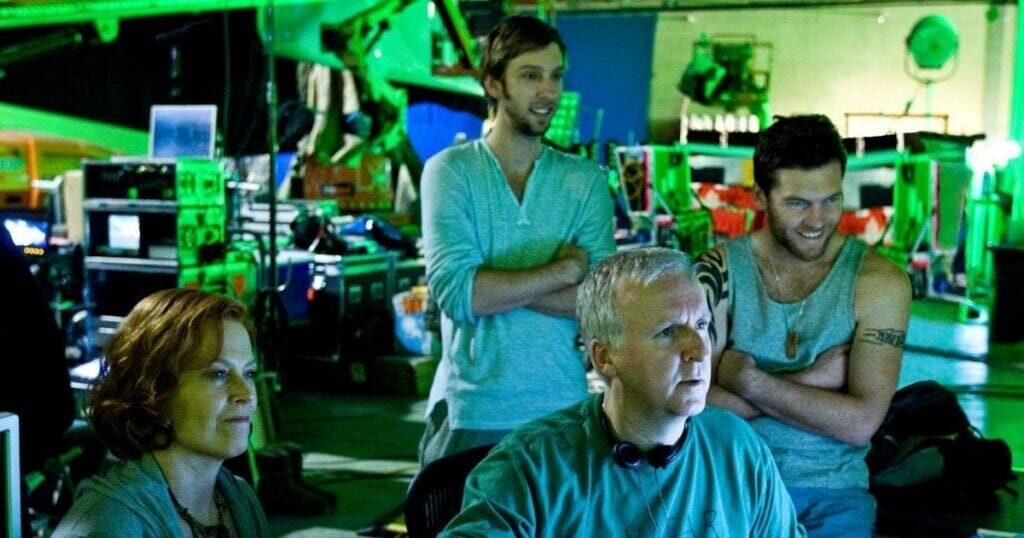
When Avatar was eventually released in 2009, it would once again smash box office records and become the highest-grossing film of all time – a record it would successfully keep until Marvel had to come along and ruin the whole thing with a little film called Avengers: Endgame. At this point, Cameron has a number of Avatar sequels in development, and we’re sure he’ll figure out a way to digitally dazzle us once again when they are finally released.
How Are Rolex and James Cameron Connected?
Ironically enough, the connection between James Cameron and Rolex has to do with a genre of filmmaking of Cameron’s that we haven’t explored yet – you see, Cameron also made several documentaries as well. In 2003, he made Ghosts of the Abyss, and in 2005, he made Aliens of the Deep, both of which involved him doing undersea discoveries and documenting them. Even as an adult, Cameron never lost his childlike love and interest for exploration, one that he would finally be able to indulge as an adult.
In 2012, James Cameron set another world record – only this one had nothing to do with movies. On March 26, 2012, James Cameron successfully piloted a submarine on his own to the bottom of the Marianas Trench, making him the first person ever in human history to do so. National Geographic even filmed a documentary, entitled Deepsea Challenge 3D, to document the entire endeavor so that it could be preserved for human posterity.
What was not immediately announced at the time was that a number of companies had worked with Cameron to help him design the submersible, including, you guessed it – Rolex. When you think about it, the union makes total sense – both Rolex and James Cameron have, dare we say it, an obsession with both technical excellence and exploring the deep-sea.
However, this did not mark the end of their partnership – not by a long shot. The two would quietly continue to work together, and in August of 2014, just two years later, Rolex and James Cameron would once again team up to make history. Rolex would end up releasing the Deepsea D-Blue Dial diver watch, which they actually named after James Cameron himself. This is notable because James Cameron is the first, and, to date, only person to have a Rolex named after him by Rolex themselves – not collectors.
They also did something different in terms of the way they released the watch to commemorate the event as well. Instead of announcing it at Bezelworld (which is the annual Rolex launch event), they released it online instead, which generated a lot of press. The watch had a luscious blue dial, and the special shade of blue known as D-Blue was named as a reference to the phrase “diving blue.”
Cameron had a connection to the brand, though not as an ambassador, that had been around for years, so it made a ton of sense that he would accept this collaboration. No one except the man himself can say when he purchased his first Rolex, but he has mentioned in interviews that it was with him on the set of Terminator 2, so he’d had it for several decades before he had a watch named after him.
Also, the story of Cameron’s original Rolex sort of has an unexpected twist ending – or beginning if you will. As you no doubt have figured out by now, Cameron is pretty meticulous about his research – to the point of being obsessive, we dare say. And while he was conducting his research for Avatar, he went to South America and did a lot of research on indigenous cultures and how they are still struggling to protect their resources, even to this day.
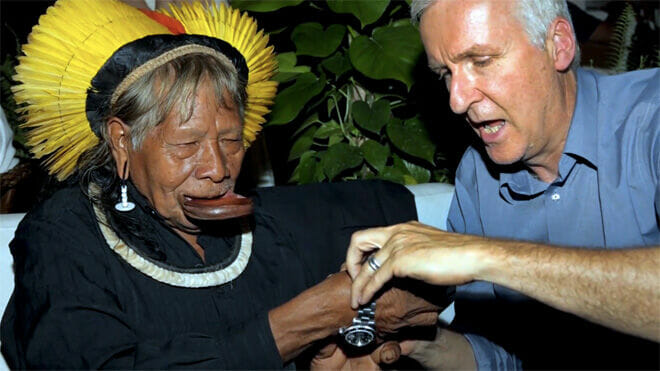
Deep in the Amazon, Cameron befriended a man named Ropni, who was the chief of the Kayapo people. The two struck up a legitimate friendship, which eventually resulted in Cameron being given a naming ceremony and being named an honorary member of the tribe. In indigenous cultures, this is often the highest honor that can be bestowed upon a person.
Cameron was deeply thankful for the opportunity, and he wanted to give the tribe chief something back as a way to repay him for all of his kindness. After struggling for a little while with a way to repay him for the monumental gesture, he gave the man something that had immense sentimental value to him – his original Rolex. So now, James Cameron’s Rolex has found a new home and a new owner, somewhere deep in the Amazon jungle.
Don’t feel too bad for James Cameron though – he was able to purchase himself a replacement, after all, and he got a whole luxury timepiece named after him to boot. Furthermore, the entire experience would light a fire in him that continues to this day to continue to advocate on behalf of indigenous cultures around the world. Who would have thought so much passion could stem from such a single watch?
So there you have it – now you fully understand the connection between James Cameron and Rolex, and how the two are now inextricably linked forever. Both the watchmaker and the filmmaker have consistently displayed unparalleled commitment to quality and innovation, and we are certain that will not change anytime soon. However, this is not the end of our story.
You see, like any good movie, we still have one more twist waiting for you. The James Cameron Sub-Mariner would only last for a couple of years before it would end up being discontinued by Rolex, for reasons that still have not been made entirely clear, even to this day. Of course, this would mean that they would end up having to come up with a new Rolex Sub-Mariner model to release for the public, right?
And so that was exactly what they did. Just a few years later, Rolex would end up releasing two new and competing models of the Sea-Dweller. For reasons that do not entirely make sense, they were given the same model number as well – 12660, replacing the 11660 that was the James Cameron model. But were the new watches actually a technical improvement? Was there really a need to discontinue the James Cameron watch in the first place?
To further answer that question, let’s take a few moments to look at the technical specs of each of these watches in a little more detail and see how they stack up.
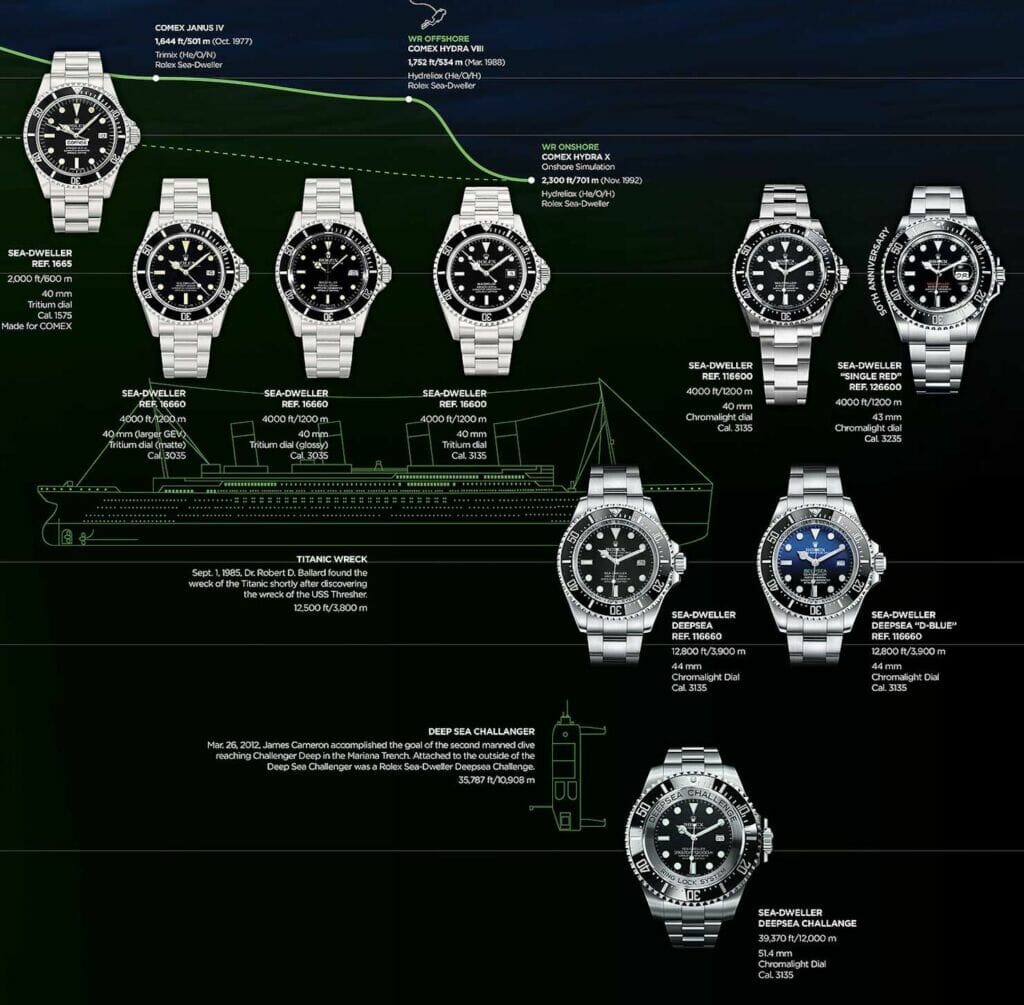
2018 Rolex Deepsea Sea-Dweller D-Blue 126660 Luxury Watch
The new Rolex Deepsea D-Blue Dial ref. 126660 was first released in August, only getting better if that’s even possible at all. This is the epitome of an ultra-resistant diver’s watch designed by Rolex to conquer the deep, a watch tank with a 44 mm case and an ultra-thick case design, 17.7 mm thick. The Rolex Deepsea D-Blue Dial ref. 126660 was initially released under reference 116660 to celebrate James Cameron, waterproof to a depth of 12,800 feet-3,900 meters
Things to Know
The dial is a perfect gradient blue that goes all the way from brilliant blue to bottomless black, equipped with the most unique dial ever released by Rolex. At the bottom of the Mariana Trench, this two-color gradient dial celebrates the journey of one man to the deepest place on earth. Like no other Rolex dial out there, the dial captures light with a semi-glossy finish. Rolex added a small coronet at six o’clock for this specific new updated version of the Deepsea D-Blue Dial ref. 126660 to mark that this watch is powered by the new Rolex calibre 3235 instead of the previous reference 3135.
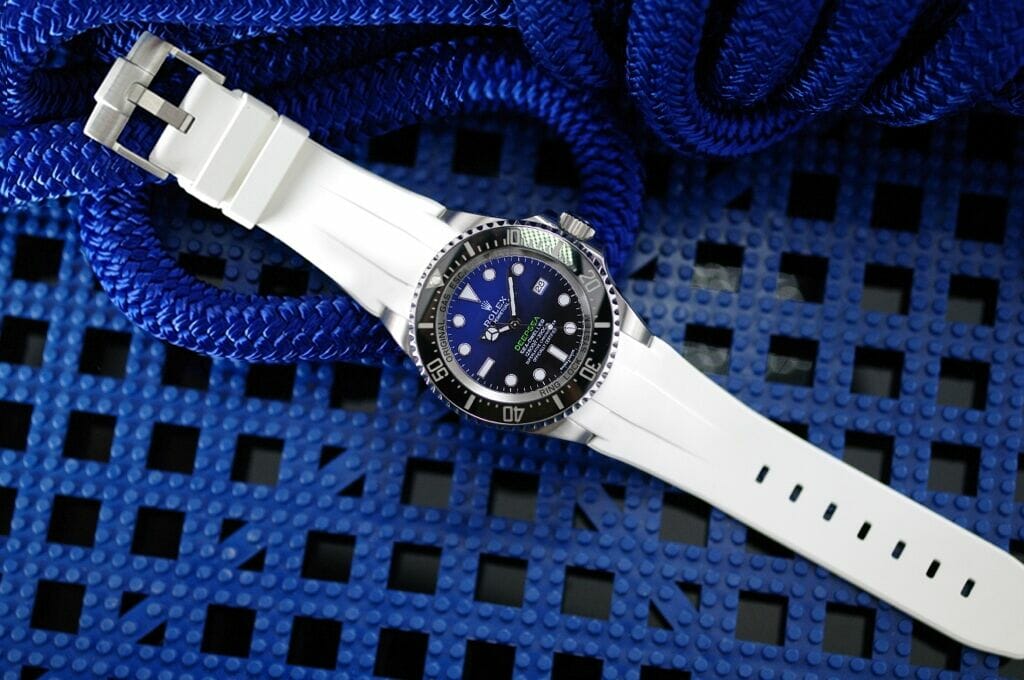
we can say that this new reference appears to have a slightly darker blue hue. The original apple green color on the ‘Deepsea’ writing now also seems to be more of a green Rolex. The new Deepsea D-Blue reference 126660 is shown left, and the Deepsea D-Blue Dial reference 116660 is shown in the right.
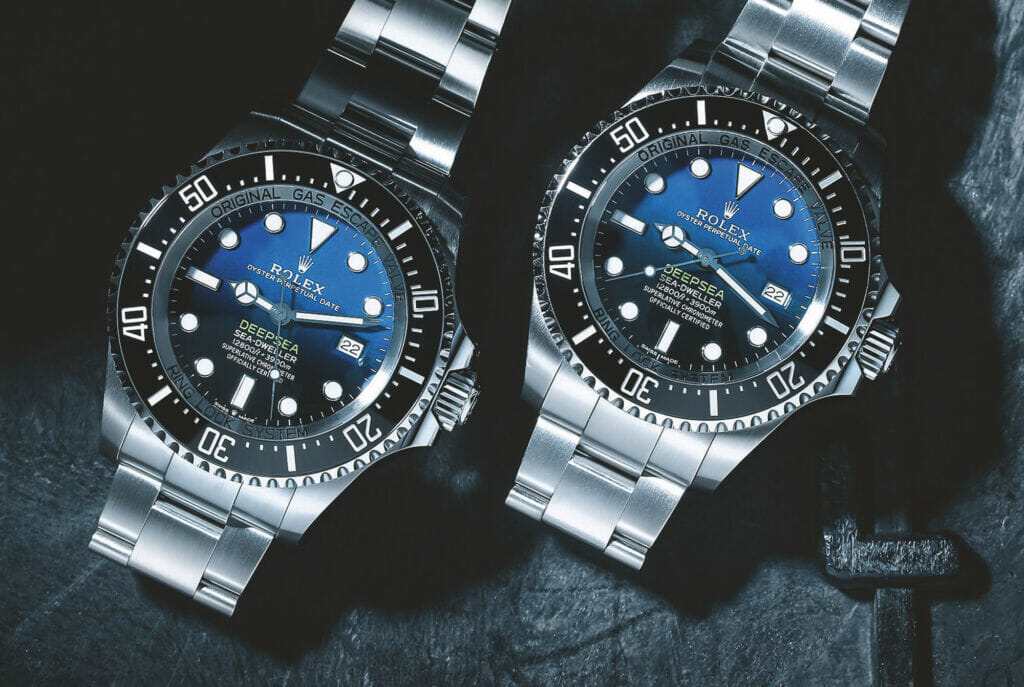
The Bezel & Case
The bezel is equipped with a unidirectional scratch-resistant ‘cerachrome’ bezel, which is 60 minutes long with numerals and platinum-coated graduations so that the running time is controlled smoothly and precisely. Rolex Deepsea D-Blue Dial ref. 126660 a.k.a James Cameron D-Blue Dial ref. A monobloc 44 mm stainless steel middle case with screw-down grade 5 titanium case back and Rolex Ringlock System case architecture with helium escape valve comes with the Rolex Deepsea Sea-Dweller D-Blue dial ref. 116660.
If some of you don’t know how the Rolex Ringlock system works or do not remember, let us refresh your memory. This innovative Rolex-patented case architecture enables the watch to withstand massive water pressure at 3.900 meters (12.800 ft.), equivalent to a weight of about 3 tons on the watch. Their construction consists of three elements: a central steel nitrogen-alloyed ring that forms the backbone of the system, together with a 5.5 mm-thick saphir dome crystal and a 5 mm titanium case.
The Movement
The new Rolex in-house automatic caliber 3235 is powered by the new Rolex Deepsea D-Blue Dial 126660. Rolex is a new movement with 14 patents that offers essential gains in terms of precision, power reserve, shock, and magnetic field resistance, comfort, and reliability. It’s a new generation movement. It incorporates the new Chronergy exhaust, patented by Rolex, combining the existing Paramagnetic blue Parachrome Hair Flowers with high energy efficiency with great reliability. The escapement is also anti-magnetic, with nickel-phosphorus, providing a power reserve of 70 hours if it is completely wound.
On the Wrist
The watch is still slightly larger on the wrist than its actual size and more like a 45 mm clock. Maybe the most remarkable wearability difference is how well and balanced the clock feels on the handle. A superb look, with its updated strap and a new movement that just got better.
What Do You Need to Know About the Rolex Sea-Dweller 43mm 126600?
In 2017, Rolex released the model number 126600 – the Rolex Sea-Dweller 43. Officially, they were released to commemorate the 50th anniversary of the release of the original Sea-Dweller 40mm, which was released all the way back in 1967.
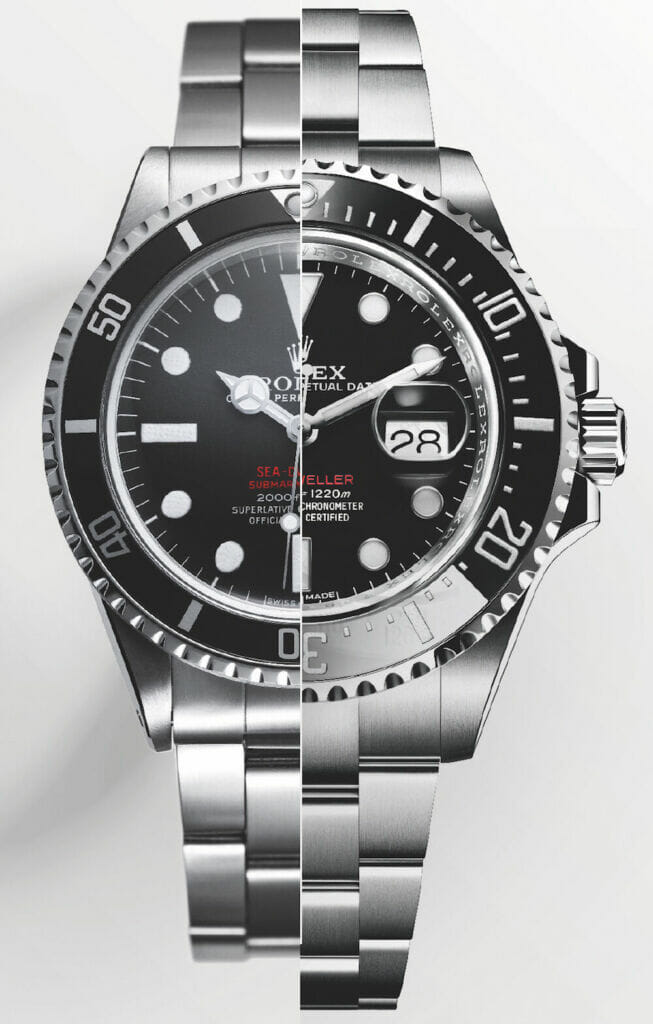
The Newer Rolex Sea-Dweller is 43mm, which made it less thick than its prior incarnation. Many consumers felt that this made it easier to wear, as it was less top-heavy than the Deep-Sea version 116660. It also had a new movement, the 3235 caliber, which required no less than 14 new patents to make.
The new movement is notable here, as the one the Rolex Sea-Dweller 43mm has is comprised of 90% new parts when compared to the previous movement. Rolex obviously heard whatever complaints had been issued about the Deep-sea 44mm 116660 models being too bulky and wanted to be certain that the Sea-Dweller 43mm 126600 addressed those concerns in full.
This watch also came with a new escapement that was more shockproof, which is very convenient for those who were using it for diving or other physical activities. It also had a 70 hours reserved, which was a massive step up from the old model, which clocked in at a comparatively underwhelming 40 hours by comparison.
The Rolex Sea-Dweller 126600 has a beautiful ceramic bezel and a glossy dial with white gold markers. The end links are flush against the case for this model, which only further adds to the already significant elegance of the watch’s overall aesthetic.
The movement of this watch is also notable as well. It has an anti-magnetic hairspring made from an alloy of nirobium and zirconium, and like its companion watch, the Sea-Dweller 43mm 126600, it also has Waterproof to 1,220 meters / 4,000 feet, helium escape valve. There are also two notable things about the dial for this watch that are worth mentioning.
After 40 years they decide to bring back the name of the watch is written in red lettering on the dial. This is unusual for Rolex watches and is believed to be a callback to the original Rolex Sea-Dweller model. It also has a magnifying window on the crystal, which makes it the first Rolex Sea-Dweller watch to ever have this feature.
Customize Your Rolex Sea-Dweller 43mm 126600 or Deep-sea Sea-Dweller 126660 With Custom Rubber Watch Straps Today
Once you purchase a Rolex Deep-sea 126660 or a Rolex Sea-Dweller 43 126600, the obvious next step is to customize the watch with rubber watch straps. This will allow you to add your own personal style and touch to the watch instead of wearing the same old bracelet time and time again when you are out and about. By customizing your watch with rubber watch straps, you will feel as if you are wearing a new watch each and every time you switch out the bracelet for a rubber watchband.
Rubber B is one of the leading manufacturers of custom rubber watch straps in the world, and we have staked our entire reputation, much like Rolex and James Cameron have, on our unwavering commitment to quality. All of our custom rubber watch bands are made exclusively in Switzerland and are comprised of 100% vulcanized rubber. They are also subjected to a series of rigorous quality assurance tests to ensure their durability.
Additionally, our watches are hypo-allergenic, dustproof, and waterproof, as well as being both FDA and BGVV certified. This means that if you have any kind of allergies, you can still wear one of our custom rubber watch bands without any issue at all. We also offer custom rubber watch straps for a wide variety of products, including the 126600 case – Sea-Dweller 43mm and 126660 case – Deepsea Sea-Dweller. If you do not own one of those particular models of Rolex, you can still see our complete catalog of Rolex rubber watch straps right here.
Rubber B is also proud to ship to clients all over the world, and we strive to make shipping as easy as possible so that we can focus on what we really love – making the best custom rubber watch straps in the world. To that end, we charge a flat shipping fee of $30 for all of our products. Anything after that is covered by Rubber B, which we proudly do as a courtesy to all of our many international customers.
If you are interested in custom rubber watch bands for other luxury timepieces, we have those available as well. Please consult our website to see our complete list of products that are currently available in our catalog. Furthermore, we are constantly updating our catalog, so please feel free to check back on a regular basis to see what new products we have recently added to our current stock.
Finally, if you ever have any questions about one of our products, please do not hesitate to reach out to us with your inquiry. One of our dedicated customer service representatives will be more than happy to answer any questions you may have about all of our products.




